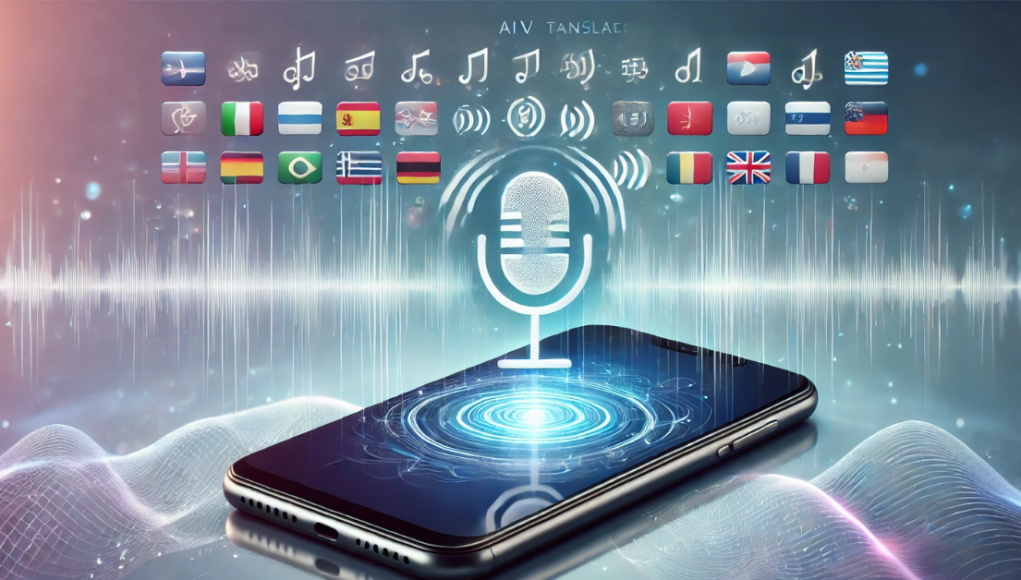Language barriers have always posed challenges in communication, especially in our increasingly globalized world. However, with the advent of AI voice translator tools, these barriers are being shattered. The best AI voice translator tools today offer powerful features that can instantly translate spoken words into different languages, making cross-cultural communication seamless and more accessible than ever. Whether you are traveling abroad, conducting business with international partners, or just trying to learn a new language, having a reliable voice translator app can be a game-changer.
In this article, we’ll explore the best AI voice translator tools currently available, highlighting their features, benefits, and what makes each one stand out. Whether you’re looking for accuracy, ease of use, or advanced AI capabilities, there’s a tool on this list to meet your needs.
How Do AI Voice Translator Tools Work?
Before diving into the best AI voice translator tools, it’s important to understand how these tools function. At their core, AI voice translators are designed to convert spoken language into another language in real time. They do this by combining several advanced technologies:
1. Speech Recognition
The first step in voice translation involves converting spoken words into text. AI-powered speech recognition algorithms analyze the sound waves of your voice and break them down into phonetic components. Furthermore, these components are then matched with words in the source language.
2. Natural Language Processing (NLP)
Once the speech is converted into text, Natural Language Processing (NLP) comes into play. NLP is responsible for understanding the context and meaning of the spoken words. It analyzes the structure of sentences, identifies key phrases, and determines the appropriate translation based on the context.
3. Machine Translation
After understanding the text, the tool uses machine translation algorithms to convert the text from the source language into the target language. in addition to this modern AI translators use advanced models like neural networks, which have been trained on vast datasets, to produce more accurate and contextually appropriate translations.
4. Text-to-Speech Synthesis
Finally, the translated text is converted back into speech using text-to-speech (TTS) technology. This allows users to hear the translation spoken aloud in the target language. Advanced TTS systems can also adjust the tone, pitch, and speed of the voice, making the translation sound more natural.
5. Continuous Learning
AI voice translators are not static tools. They continuously learn and improve over time. As users interact with the app, it collects data on common phrases, pronunciation, and translation preferences, refining its algorithms to provide better and more accurate translations in the future.
Best AI Voice Translator Tools
1. Notta: Best for Accurate Voice Transcriptions & Translations
Notta is a standout AI voice translator tool, particularly for those who need precise transcriptions and translations. Designed to be a comprehensive platform, Notta doesn’t just translate; it transcribes audio in real-time with impressive accuracy. This tool supports over 50 languages for translation and 58 languages for transcription, making it incredibly versatile.
Key Features:
– Real-Time Transcription and Translation: Notta excels at converting spoken language into text and translating it instantly, boasting an accuracy rate of 98.86%.
– AI-Powered Summarization: Beyond translation, Notta can summarize lengthy transcripts, making it ideal for meeting notes and lectures.
– Cross-Platform Compatibility:Available on iOS, Android, and web, ensuring you can access your translations anywhere.
– Cloud Storage: Automatically save and organize your transcripts and translations on the cloud for easy access and sharing.
Pros:
– Supports a wide range of languages.
– High transcription accuracy.
– User-friendly interface.
Cons:
– Requires an active internet connection.
– Some features are locked behind a paywall.
Pricing:
– Free Plan
– Pro Plan: $14.99 per month
– Business Plan: $27.99 per month
2. Google Translate: Best for People with Hearing Issues
Google Translate is one of the most well-known AI voice translator tools, and for a good reason. It’s free, easy to use, and offers extensive language support. While it may not always be the most accurate, its simplicity and accessibility make it a go-to option for many users.
Key Features:
– Wide Language Support: Google Translate supports 133 languages, covering almost all the popular languages worldwide.
– Live Translate: Converts spoken words into text, which can be read by those with hearing impairments.
– Offline Translation: Download language packs for offline use, although this feature is only available on Android.
– Camera Translation: Use your device’s camera to translate text on images, such as signs or menus, in real time.
Pros:
– Completely free to use.
– Supports a broad range of languages.
– Includes features like image and document translation.
Cons:
– Offline translation is limited to Android.
– Accuracy can vary, especially with complex phrases.
Pricing:
– Free
3. Apple Translate: Best for Basic Translations on iOS
Apple Translate is the default voice translator tool on iOS devices, designed to offer simple and quick translations. While it doesn’t support as many languages as other tools, its deep integration with iOS makes it a convenient choice for iPhone and iPad users.
Key Features:
– System-Wide Integration: Apple Translate works seamlessly across iPhone and iPad devices, allowing you to translate text and voice inputs effortlessly.
– On-Device Mode: Perform translations without an internet connection, ensuring privacy and data security.
– Conversation Mode: Facilitates real-time translated conversations, ideal for face-to-face communication.
Pros:
– Free and pre-installed on iOS devices.
– Easy to use with a clean interface.
– On-device translation ensures privacy.
Cons:
– Limited language support (18 languages).
– Lacks advanced AI features compared to competitors.
Pricing:
– Free
4. iTranslate: Best for Translating Text on Images
iTranslate is a versatile AI voice translator tool known for its ability to translate text within images. This feature is particularly useful for travelers who need to understand signs, menus, or any other written text in a foreign language. In addition to image translation, iTranslate supports voice-to-voice translation and even offline use.
Key Features:
– Image Translation: Use your device’s camera to scan and translate text from images in over 100 languages.
– Voice-to-Voice Translation: Communicate directly with people in different languages using the voice translation feature.
– Offline Mode: Download language packs to use the app without an internet connection.
Pros:
– Supports over 100 languages.
– Offline translation available in the pro version.
– User-friendly interface with a clean design.
Cons:
– Ads in the free version can be intrusive.
– Some features require a paid subscription.
Pricing:
– Free Plan
– Pro Plan: Contact Sales
5. AI Voice Translator Translate: Best for Translating on iOS Devices
AI Voice Translator Translate is a powerful app designed specifically for iOS users. This tool is perfect for those who prefer simplicity combined with powerful AI features. Besides this it offers two distinct voice output settings, allowing users to listen to translations in either a male or female voice.
Key Features:
– Customizable Voice Output: Choose between male and female voice output for translated text.
– Extensive Language Support: Translate voice inputs into over 100 languages.
– User-Friendly Interface: Designed with simplicity in mind, making it easy to navigate.
Pros:
– Free for iOS users.
– Customizable voice output.
– Supports a wide range of languages.
Cons:
– Limited to iOS devices.
– Accuracy can be an issue with complex sentences.
Pricing:
– Free
6. Microsoft Translator: Best for Microsoft Office Users
Microsoft Translator is a robust AI voice translator tool that integrates seamlessly with Microsoft Office products. This tool supports more than 70 languages and offers both online and offline translation modes, making it a reliable option for business professionals and travelers alike.
Key Features:
– Integration with Microsoft Office: Easily translate text within Microsoft Word, Excel, and other Office products.
– Offline Translation: Download language packs for offline use, ensuring you can translate without an internet connection.
– Conversation Mode: Facilitates real-time translated conversations across multiple languages.
Pros:
– Free to use with in-app purchases available.
– Integrates well with other Microsoft products.
– Supports both voice and text translations.
Cons:
– Offline translation options are limited.
– Fewer language options compared to Google Translate.
Pricing:
– Free
Who Can Benefit from Using AI Voice Translator Tools?
AI voice translator tools are incredibly versatile and can benefit a wide range of users. Here’s a closer look at who can make the most out of these innovative applications:
1. Travelers
For frequent travelers, language barriers can be a significant hurdle. AI voice translators make it easier to navigate foreign countries, communicate with locals, and understand important information such as signs, menus, and public announcements. With offline capabilities, travelers can also use these tools without worrying about connectivity issues.
2. Business Professionals
In today’s globalized economy, businesses often operate across multiple countries and languages. AI voice translators can facilitate smoother communication between international teams, during meetings, or when negotiating with foreign clients. They are also invaluable for translating documents and emails, ensuring that language differences don’t impede business operations.
3. Language Learners
Learning a new language can be challenging, but AI voice translators can provide valuable support. By listening to translations and practicing pronunciation, learners can improve their language skills more effectively. These tools can also help learners understand unfamiliar words or phrases in real-time, making the learning process more interactive and engaging.
4. Educators and Students
In educational settings, AI voice translators can be used to bridge language gaps between students and educators who speak different languages. This is particularly useful in multilingual classrooms or when providing educational resources to students from diverse linguistic backgrounds. For students, these tools can help with language studies and facilitate better communication in group projects involving international peers.
5. Healthcare Providers
Healthcare professionals often interact with patients who speak different languages. AI voice translators can help in providing better care by ensuring that medical instructions, diagnoses, and treatment plans are communicated clearly and accurately. This can be especially crucial in emergency situations where quick and accurate communication is vital.
6. Deaf and Hard of Hearing Individuals
AI voice translators, like Google Translate’s Live Translate feature, can convert spoken words into text, making them accessible to deaf and hard of hearing individuals. This feature helps in everyday conversations, enabling them to participate more fully in social interactions and reducing the communication gap.
How to Choose the Best AI Voice Translator Tool?
Selecting the right AI voice translator tool depends on your specific needs. Whether you’re looking for accuracy, ease of use, or advanced features, here are some factors to consider when making your choice:
1. Accuracy
The most critical factor in a voice translator tool is its ability to accurately convert spoken words into the desired language. While some apps boast high accuracy rates, others may struggle with complex sentences or less common languages. If accuracy is your priority, tools like Notta, with an accuracy rate of 98.86%, might be the best choice.
2. Language Support
Another important consideration is the range of languages supported by the app. Google Translate, for instance, supports over 130 languages, making it a versatile option for global travelers. On the other hand, Apple Translate is more limited, with only 18 languages available.
3. Ease of Use
A user-friendly interface is essential, especially for those who are not tech-savvy. Most of the apps on this list are designed with simplicity in mind, but tools like iTranslate and Apple Translate stand out for their clean and intuitive designs.
4. Offline Capabilities
If you need to translate languages without an active internet connection, look for apps that offer offline mode. Microsoft Translator and iTranslate provide this feature, though it may be limited to certain languages.
5. Additional Features
Advanced features like image translation, transcription, and voice output customization can enhance the functionality of a voice translator tool. Notta offers a comprehensive set of AI-powered features, while iTranslate provides image translation capabilities that are useful for travelers.
6. Integration and Sharing Options
For professionals who need to integrate their translations with other software, tools like Microsoft Translator offer seamless integration with Microsoft Office products. This can be a significant time-saver if you frequently need to translate documents or presentations.
7. Privacy and Security
When using a voice translator, especially one that stores data on the cloud, privacy is a critical concern. Look for tools that offer on-device translation options, like Apple Translate, or those with strong data encryption methods to protect your information.
8. Customer Support and Updates
Reliable customer support and regular updates are essential for any app you rely on for important tasks. Choose a tool with a solid track record of customer support and frequent updates to ensure it keeps up with the latest language trends and AI advancements.
The Future of AI Voice Translation
AI voice translation technology is rapidly evolving, and the future holds exciting possibilities. As AI models become more sophisticated, we can expect even higher accuracy, faster processing times, and more nuanced translations that better capture the subtleties of human language. Here are some trends to watch for in the coming years:
1. Contextual Understanding
Future AI voice translators will likely improve their ability to understand context, which is crucial for accurate translations. This means better handling of idioms, slang, and cultural references, providing translations that are not just literal but also contextually appropriate.
2. Multimodal Translation
We can expect the integration of multimodal translation capabilities, where AI tools can simultaneously process and translate multiple forms of input—such as text, speech, and images. This will create more seamless and natural interactions, especially in complex environments like business meetings or international conferences.
3. Real-Time Collaboration
As collaboration tools become more integrated, we could see real-time voice translation embedded directly into platforms like Zoom, Microsoft Teams, and Slack. This would enable more effective communication in international teams, breaking down language barriers without interrupting the flow of conversation.
4. Improved Accessibility Features
Future advancements may also focus on enhancing accessibility, particularly for those with disabilities. For instance, AI translators could provide more refined speech-to-text translations for the deaf and hard of hearing, and offer voice translations tailored for individuals with speech impairments.
5. Greater Customization and Personalization
AI translators may soon offer more personalized experiences, learning individual users’ speech patterns, preferences, and frequently used phrases. This customization would lead to more accurate and efficient translations, tailored to each user’s specific needs.
Conclusion
The best AI voice translator tools offer a range of features to help you break down language barriers, whether you’re traveling, conducting business, or simply trying to learn a new language. From the high accuracy of Notta to the comprehensive language support of Google Translate, there is a tool to meet every need. As AI technology continues to evolve, we can expect these tools to become even more powerful and essential in our daily lives.





